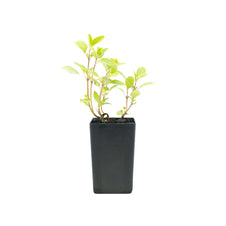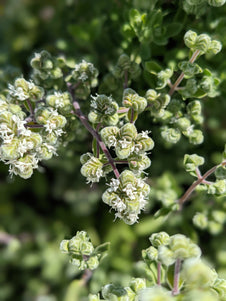





Marjoram - Sweet Marjoram
Marjoram - Sweet Marjoram

- In stock, ready to ship
- Inventory on the way

Usually available: April to November
Life cycle: Perennial
Height: 25 - 50cm
Position: Full sun
Soil preference: Well drained
This is how we pack and send your Herb Plants to all states except TAS & WA
You will receive
- 1 Sweet Marjoram Herb Plant in a 50 X 75mm tube - General growing instructions
All of our Herb Plants are grown organically with certified organic potting mixes and fertilizers
Botanical Name: Origanum majorana
Marjoram, also called sweet marjoram is a bushy, perennial growing 25-50 cm high and wide. The highly aromatic leaves are small, oval shaped and have fine hairs. The leaves take on quite a light green appearance on the top, but underneath they are a grey-green colour. In some regions of the world, marjoram is synonymous with oregano. In these areas, the plant is called knotted marjoram as a means of distinguishing it, due to the appearance of the tiny flowers in tight clusters prior to blooming. The tiny, white to lilac, flowers bloom in summer and give way to tiny, light brown seeds.
The native habitat of marjoram is the dry Mediterranean and the herb is much valued by Italians for its culinary uses. The origins of marjoram also include North Africa, India, The Middle East, Cyprus and Portugal. This herb was known to the early Greeks and Romans as a symbol of happiness and marjoram was worn at Roman weddings.
You can pick the fresh leaves for use at any time. The leaves and stems can be harvested for drying soon after formation of the flowers buds (or knots), but before blooming of the flowers. Cut the stems about 5 cm to the ground and then hang upside down to dry in a cool, shady spot. After they have dried, discard the stems off and store the dried herb in airtight jars. To freeze marjoram, chop finely, mix with water in an ice cube tray and freeze.
Marjoram is an attractive ground cover or low shrub and is a valuable addition to a garden border or rockery, even just for the aromatic leaves. It is also highly attractive to bees and any garden would benefit from the addition of marjoram.
Growing Conditions
Marjoram prefers to grow in warmer areas, with full sun. It survives warm summers well, with moderate water and can tolerate dry periods. It is not happy in wet areas, so loose, well-drained soil is required where summer or tropical rains are common. Although marjoram evolved in poor, dry soils, it does well with some addition or organic matter as long as the soil does not become too acidic.
In many countries, marjoram is treated as an annual plant, because it does not survive frost or cool conditions and must be replanted every year. In cooler conditions, and many countries of the world, marjoram is grown inside. The plant does well in containers and can be attractive in a hanging basket.
Marjoram is grown from seed but the seeds are slow to germinate, so it is best to plant them out in trays first. Propagation is also possible from 8cm long woody, stem cuttings taken in autumn or late spring – depending on your region and local advice. Once roots are established the plant can be transferred to the garden. Alternatively, mature plants can be divided in autumn and placed elsewhere in the garden. To encourage new growth in spring, the plant can be trimmed lightly in late winter.
Culinary Uses
Marjoram is used in bouquet garni, has a taste resembling mild oregano and may be used as a substitute for this herb. A favourite with Italians, marjoram is used in an extensive range of meat, poultry, vegetable and eggs dishes. As a dried herb, marjoram makes a refreshing herbal tea and is used to good effect in herb bread, stuffing and when added to vinegar and oil dressings. The freshly harvested leaves and flowers may be used in salads and all forms of cooking, but add towards the end of cooking for hot dishes.
Medicinal Uses
Marjoram is primarily a culinary herb, however there also is an extensive history of medicinal use. The essential oil produced from the flowers, leaves and stems of marjoram contains active components including borneol, camphor and pinene contribute to the anti-spasmodic and stimulant properties. Marjoram has seen medicinal use in many ways including as a topical agent for sprains, bruises, general aches and muscle pains where the analgesic properties can help reduce pain. It has also been used for digestive and intestinal complaints, such as bloating, and respiratory problems, including cough and cold symptoms. Due to the general relaxant properties of marjoram, it is helpful for nervousness and insomnia, tension headaches and migraines. The anti-bacterial and anti-fungal benefits of marjoram are useful in treatment of open wounds and skin conditions.
Other Uses
A marjoram infusion is traditionally as a hair rinse by brunettes.
Companion Plants
Marjoram is a good companion to capsicum, chilli and sage. Since the flowers are a bee attractant, the garden will benefit from the presence of marjoram.
All information provided on this website is for informational purposes only. Please seek professional advice before commencing any treatment.





